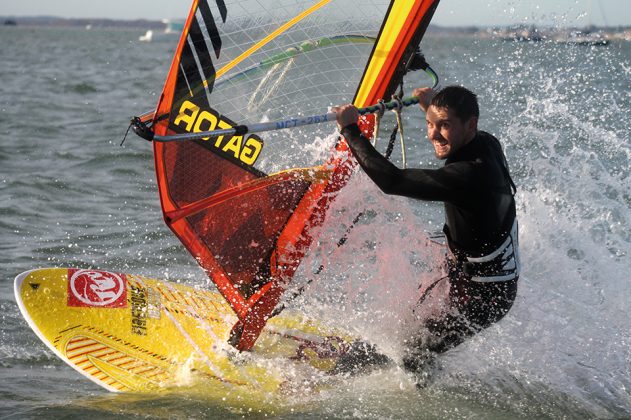With the temperatures starting to rise, is your body ready to go through the windsurfing wringer? Sam Ross, RYA instructor trainer and coach, talks fitness.
Words & Photo Sam Ross
Getting the best out of your windsurfing and mastering more progressive manoeuvres means being able to push yourself on the water while minimizing fatigue and reducing the risk of injury. You want your practice time to be as productive as possible, which comes down to getting your body windsurfing ready. So, depending on the type of windsurfer you are, what should you focus on?
Freeride
What end of the freeride spectrum you favour typically depends on what conditions are most local to you. If you sail regularly in choppy waters, it’s more leg biased and has the most impact on your knees. If you sail inland, it’s likely to be more shifty and gusty so you need to pump and you need good core strength to have control over your stance and to get through the gusts and lulls. The more you’re pushing and crashing the higher your heart rate peaks will be. Cruising back and forth and it will tend to be a steadier, more aerobic workout.
Slalom and course racing
Both these disciplines have similarities in that they are competitive racing classes although are very different in terms of demands on the body and duration.
In slalom you’re sailing fully loaded all the time; it’s short, explosive activity typically lasting about five minutes with high heart rates. Interval training, including short sessions on the rower, can be really good for this. Keeping the board flat while sailing is key, so good leg strength is required. For course racing a lot depends on wind strength and the fact you cannot change your sail to suit the conditions as you can in slalom. Strong winds require similar elements to slalom, and although the races tend to be longer at 15-20 minutes, it’s still high intensity requiring good leg strength. In light winds, a race can be 45 minutes and pumping is your priority. Shoulder stability and the ability to push and pull through your back are critical. It requires a huge amount of more aerobic work to sail at your maximum for that duration. This means building a good aerobic base, getting out on the bike for long periods as well as building the required strength elements on top.
Freestyle and wave
Of all windsurfing disciplines, wave and freestyle will likely see you on smaller sails, spending a higher percentage of time unhooked and in high winds. Your body is likely to get most contorted, increasing the risk of twist injuries, strains and sprains.
Explosive power is needed to master the fast moves to make the most of the conditions. A lot of that comes down to handling the rig, which requires great stability in the shoulders and back. Getting good height in jumps and rotation in freestyle comes from your lower back and legs.
Legs are one of the most overlooked yet important muscle groups in windsurfing; hamstrings especially tend to shorten making them a high-risk area that need looking after. It’s also not uncommon for freestyle sailors to have poor posture from hunching, again potentially making someone prone to injuries.
Power at reach is key; this gives you more control mid-move or rotation. So whilst building strength is important this will also come with increased flexibility through appropriate strength and conditioning and yoga and/or Pilates.
Never underestimate the importance of warming up and cooling down too in making sure your muscles and joints are ready and restored before and after action.
To get you started…
We asked Tim Jones, British Sailing Team Sports Scientist, for three good all-round fitness tips to help your windsurfing this year.
1. Glute bridges – enhances strength in your gluteal muscles to aid pumping and help offload strain on your lower back. Lie face up on the floor, knees bent and feet flat with your arms palms down at your side. Lift your hips until your knees, hips and shoulders are in a straight line. Hold for a few seconds then lower. Do three sets of 10-15 bridges at least three times a week. Using a resistance band makes it harder, while single leg bridges can help progression too.
2. Long jumps and jump squats – to develop explosive power in your lower body. Try doing on grass or sprung floors to reduce impact on joints. Begin with less than 30 contacts per session (e.g. 6 x 5 reps) and increase by a maximum of five contacts per week up to 50 in total.
3. Assessing shoulder stability – the ability to pull and press should be close to equal. Performing the maximum amount of press-ups and bent-knee supine pulls will dictate where work is needed. Press-ups, or pull movements possibly using a suspension trainer or a bar at home or in a gym, will help improve stability.
For more information about getting into windsurfing visit www.rya.org.uk/go/getafloat or to find the right RYA training course for you, visit www.rya.org.uk/go/training

